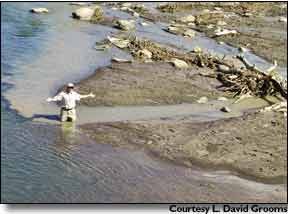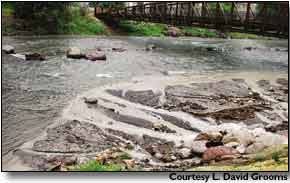|

Cloud of
discord hangs over proposed erosion control
City
restrictions go beyond U.S. law
August 31, 2003
By Dale Rodebaugh
Herald Staff Writer
As the
requirements of the federal Clean Water Act trickle down to smaller
cities, Durango is considering an erosion-control measure that isnít
popular in all quarters.
|
 |
|
Mike Paterniti stands in the Animas
River at the confluence with Lightner Creek to call attention to the
debris and dirt that wash into the river from various sources.
Paterniti is a partner in the fishing business proFlyFishers. |
While outdoor
interests hail the measure for its protection of waterways, builders say
itís an additional burden Ė one of questionable results and unknown cost.
The proposed
amendment to the cityís Land Use and Development Code would require
builders to obtain a permit before they break ground.
Builders would
have to explain how they intend to keep sediment out of storm drains Ė and
ultimately the Animas River Ė and how they plan to stabilize the landscape
after construction.
No one knows how
much sediment and debris finds its way now into the Animas River, a
gold-medal fishing area through Durango.
Although the
amount hasnít been quantified, itís certainly visible, according to Mike
Paterniti.
"Itís evident from
walking the river that damage is being done," said Paterniti, a partner in
proFlyFishers, which offers clinics and package trips.
In fact, Paterniti
almost three weeks ago alerted the federal Environmental Protection Agency
about two stretches of the Animas River where debris and sediment have
collected.
"There is a
colossal quantity of material that is waiting for the next rains to bring
it down," Paterniti said.
"There is natural
erosion, but weíre compounding it," he said, pointing to private, city,
county and state contributors.
The sections of
the Animas that concern Paterniti are Schneider Park near River City Hall,
where a culvert empties into the river, and the confluence of Lightner
Creek about a mile downstream.
The areas are
spawning grounds for cutthroat and rainbow trout in the spring and the
brown trout in the fall, Paterniti said.
Pollution can
start a domino effect, Paterniti said. If silt and debris cover their
spawning grounds, fish may move to other areas, increasing pressure there.
Pollution also
affects food availability and ultimately could change the dietary habits
of fish and their reproduction cycle, Paterniti said.
Jon Tuthill, an
area contractor for 22 years and currently president of the Homebuilders
Association of Southwest Colorado, doesnít quibble with controlling
construction pollution.
But Tuthill is
concerned about what he considers creeping government oversight, the
effects and costs of which are passed to homeowners.
He estimated the
code change could add up to $3,000 to the cost of a new home, depending on
the complexity of the mitigation required.
"This is going to
affect our ability to produce affordable housing," Tuthill said.
Bradley Elder,
whoís been building houses in the area for 15 years, doesnít oppose the
code amendment outright. But he questions its effectiveness and thinks
there is a better way to accomplish the same ends.
"How much sediment
are they going to stop?" Elder asked. "If you check the Animas at the 32nd
Street Bridge where it enters town and then where it leaves there may not
be not be any great degree of difference."
While the
cumulative effects of sediment and debris shouldnít be disregarded,
officials should look at the big contributors, Elder said.
"My thought is
that one hour of flow off Missionary Ridge would equal a year of storm
drain flow," Elder said.
"It may well be
that because of regulations, we canít do anything," Elder said. "But itís
worth thinking about other solutions."
Whatever action is
taken, it should be done now, Paterniti said.
Over the years,
Paterniti said, the Animas River has bounced back from the effects of
mining, forest fires and indiscriminate land management.
But failure to
deal with erosion control will put the blame for further deterioration on
the shoulders of current stakeholders, Paterniti said.
Reach Staff
Writer Dale Rodebaugh at
daler@durangoherald.com
City restrictions go beyond U.S. law
By Dale Rodebaugh
Herald Staff Writer
Itís been a long
time coming, but small-town America is now feeling the effects of a 1972
federal law that became known as the Clean Water Act.
|
 |
|
Silt and debris that has washed into
the Animas River can contribute to the deterioration of the highly
prized fishery. This photo shows detritus from a culvert on the east
side of the Animas River near Schneider Park. |
Modified numerous
times over the years, a 1990 provision established requirements for
storm-water systems in cities with more than 100,000 population. Now,
cities the size of Durango fall under the guidelines.
The goal is to
prevent sediment and debris from entering water-discharge systems and, in
the end, creeks and rivers.
For its part,
Colorado has required a storm-water discharge permit for projects
involving 5 acres or more since 1992. Last year, projects of 1 acre or
more triggered the need for a permit.
Now, a proposed
Durango ordinance would require developers of a Ĺ-acre project to get a
permit. The intent is to control sediment and debris that is carried
off-site by construction vehicles or is washed off-site.
Up to now, general
contractors and subcontractors working in the city tend to blame each
other for pollution, said Kinsey Holton, a city environmental engineer. A
code change would require the lot owner to provide a vehicle-tracking
system to determine responsibility.
|
Whatís next |
|
Durango city councilors will conduct a
hearing Tuesday on the proposed erosion-control and storm-water
quality amendment to the Land Use and Development Code.
City planning commissioners approved the
measure 5-0 last week.
The city plans to offer a 1Ĺ-day
storm-water management class Oct. 14-15. Information on enrollment,
cost and class content are available from city environmental
engineer Kinsey Holton at 385-2848. |
Agricultural
activities are exempt from the regulations.
If Durango city
councilors approve the code change, builders will need a city and a state
erosion-control permit for about six months. After that, the city will
assume responsibility for issuing permits for projects covering from
Ĺ-acre to 5 acres.
The only state
permit required will be for projects of more than 5 acres.
Durango itself
will have to meet discharge requirements, Holton said. The city already
does the following:
-
Hauls 20,000
cubic yards of snow swept from streets to 17 acres along Highway 550/160
to melt instead of being dumped into the Animas River. Water percolates
into the ground and debris is collected after the snow melts.
Five hundred cubic yards of sand and 20,000 gallons of magnesium
chloride used in snow cleanup are swept up in the process.
-
Operates a
detention basin at the Durango Community Recreation Center to catch
runoff.
|